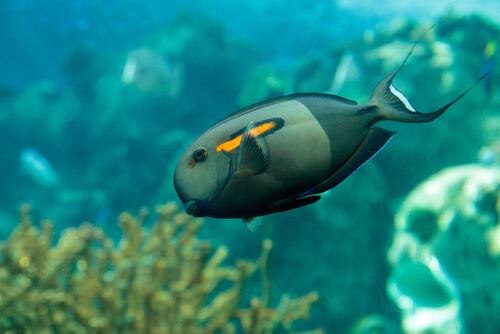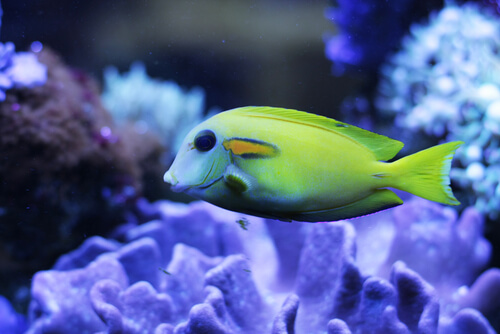Orange Shoulder Tang: Care, Appearance, Temperament & More
Posted by on 5/11/2023
We use affiliate links and may receive a small commission on purchases.
Named after the distinct marking above its pectoral fin, the Orange Shoulder Tang is an impressive, yet uncommon surgeonfish that makes a great addition to a tank large enough to house it.
The species shares similar care requirements as other Acanthurus tangs, but those new to surgeonfish should be as well informed as possible before deciding to purchase such a large fish. In this guide, we'll cover everything you'll need to know before deciding on an Orange Shoulder Tang.
January's Giveaways on Light Fish
Species Summary
The Orange Shoulder Tang (scientific name: Acanthurus olivaceus) is a unique-looking fish native to the Indo-Pacific, where it can be found up to 150 feet below the ocean's surface. The fish is relatively common in its native habitat and goes through a color change as it transitions from a juvenile into an adult fish.
Primarily an algae eater, the Orange Shoulder Tang patrols the ocean, searching for food to fuel its herbivorous diet. Found alone or in schools, the fish has even been discovered schooling with other species and has been witnessed swimming with parrotfish, and other species of surgeonfish.

Appearance
Adult orange shoulder tangs have a distinct appearance. The front half of the fish displays a white coloration, while the rear half of the fish features a muted gray coloration. The fish has a submarine-shaped body, that tapers to a lyre-shaped tail.
Perhaps its most distinct feature is the orange stripe that appears directly behind the eyes of the fish, which is outlined in a navy blue coloration. The fish's continuous dorsal fin, which also shares a similar white/gray color, is outlined in a bright orange, similar to the hue seen on the fish's shoulder.

Juvenile vs Adult
Orange shoulder tangs go through a rather drastic color change as they transition into adult fish. The body of a juvenile fish is almost entirely yellow, and won't transition to the gray color seen in adults until it reaches sexual maturity, at about 2.5 years of age.
Male vs Female
Male and Female Orange Shoulder Tangs are visually indistinguishable, but there are some differences in growth rates.
Females will typically grow much faster than males and will be close to their final size at about the 4-year mark. Males will take longer to grow, growing only a few inches in their first few years of life.
Size
Orange Shoulder Tangs grow to be quite large, and adult fish can grow to be about 14 inches in length.
Females will be only an inch or so larger than males, and hobbyists will want to provide a well-balanced diet to achieve a healthy growth rate.
Orange Shoulder Tang Care
Once established, orange shoulder tangs aren't the most difficult to care for. For most hobbyists, the biggest challenge will be providing an aquarium setup that's suitable for their large size. Once an appropriate tank size is selected, hobbyists will need to provide a diet suitable for this large herbivore.
Hobbyists will want to recreate their natural environment as closely as possible for these fish to reach their full lifespan in captivity.
Lifespan
Orange Shoulder Tangs are a long-lived species, and when well cared for, can live for up to 35 years.
Providing a large enough aquarium that's rid of any aggressive tank mates, a pristine environment, and a well-balanced diet, will help the fish reach its full lifespan.
Tank Size
The Orange Shoulder Tang should be kept in an aquarium that's at least 180 gallons in size.
While this might be the barrier to entry for most hobbyists, it's a firm requirement due to the fish's active personality and size.
Acclimation
Orange Shoulder Tangs, similar to other saltwater fish, should be drip acclimated using a drip acclimation kit over a 30-minute period.
Hobbyists will want to acclimate the fish to an established quarantine tank, where they can monitor the fish over an additional 3-4 weeks. After acclimation, they can be introduced into a display tank via an acclimation box .
Water Conditions
Orange Shoulder Tangs prefer the same water conditions as other fish native to the Indo-Pacific, and hobbyists will want to keep the following parameters as stable as possible.
Hobbyists will want to maintain the following water parameters when housing a Green Spotted Puffer.
Ammonia: 0ppm
Nitrite: < .2ppm
Nitrate: < 10ppm
Specific Gravity: 1.020-1.025
Temperature: 72°F-78°F
dKH: 8-12 dKH
pH: 8.1-8.4
Hobbyists should always perform regular water tests using a reliable test kit .
Tank Setup
Due to the fish's large size, hobbyists will have plenty of space to work with when planning their tank setup. Live rock should be added, but hobbyists will want to retain plenty of open space. Orange Shoulder Tangs are active swimmers, and will frequently be swimming back and forth throughout the tank.
Aquarists will want to provide filtration rated for their tank size, and will also benefit from an algae scrubber or refugium. Additionally, adjustable powerheads can be provided to simulate the current Orange Shoulders are exposed to in their natural habitat.
Common Diseases
Many tang species, including the Orange Shoulder Tang, are wild-caught fish. As a result, they have a higher chance of carrying harmful diseases and pathogens. Hobbyists should always have a quarantine plan in place and should examine the fish closely before introducing the species into their display tanks.
Some of the most commonly seen diseases in the Orange Shoulder Tang include internal parasites, as well as marine velvet and ich.
Food & Diet
Orange Shoulder Tangs should be fed a diet consisting of nori, spirulina, nutrient-rich flake food, and boiled or frozen zucchini 3 times a day.
These fish are known omnivores, but will also feed on mysis and brine shrimp. For those of us combating algae, Orange Shoulder Tangs will frequently pick at and consume filamentous algae and diatoms.
Behavior and Temperament
Orange Shoulder Tangs are always on patrol, searching for their next algae-based meal or investigating the behavior of other tank mates. Similar to other surgeonfish, the Orange Shoulder Tang has a scalpel-like spine near its tail fin, which it can use to slash any potential predators, including a hobbyist's hands! Aquarists should always wear gloves when servicing an aquarium containing a surgeonfish.
The Orange Shoulder Tang shares a similar semi-aggressive temperament as the Tomini Tang and Desjardini Tang. The fish is known to show aggressive behavior towards other tangs but can co-exist with other peaceful species. If possible, it's best to add an Orange Shoulder Tang to an aquarium a few months after any previous fish have been added.
Reef Compatibility
While the Orange Shoulder Tang is known to pick at algae near the base of corals, the fish is still considered to be reef safe.
Hobbyists shouldn't run into any issues keeping an Orange Shoulder Tang with chalices, torches, and other corals such as blastos.
Tank Mates
Due to their aggressive behavior towards other tangs, you'll want to avoid adding other surgeonfish including the Powder Blue, Gem, and Tomini.
Fish with a peaceful temperament can co-exist with an Orange Shoulder Tang, provided a large enough aquarium.
Some potential tank mate options include:
Other aggressive species should also be avoided, including the Green Spotted Puffer, Tessalata Eel, and Blue Spotted Puffer. Hobbyists should also avoid adding additional Orange Shoulder Tangs, as multiple males will easily result in territorial disputes.
Breeding
Unfortunately, there have been no success stories of hobbyists breeding the Orange Shoulder Tang in captivity.
However, there have been success stories breeding other types of tang fish, such as the Purple Tang and Yellow Tang . With discoveries occurring every year, hopefully, we'll see success in breeding the Orange Shoulder in the future.
Where to Purchase
Although common in the wild, the Orange Shoulder Tang can be a difficult fish to acquire. Aquarists may encounter them for sale on our marketplace, but should also phone up their local fish store to see if the species is in stock.
Luckily due to their large population size, the fish tends to be quite affordable, often selling between $50-$150 in the United States.
Conclusion
Orange Shoulder Tangs are without a doubt impressive fish. As they mature, their appearance is almost mesmerizing, and their behavior is fascinating to observe. As a bonus, their algae-eating abilities will help keep your tank pristine, but does the large tank size requirement deter you from purchasing one?
Let us know if you think the Orange Shoulder Tang will be your next fish in the comments below, and be sure to visit our marketplace and community forum where you can discuss fishkeeping with other hobbyists.
January's Giveaways on Light Fish


